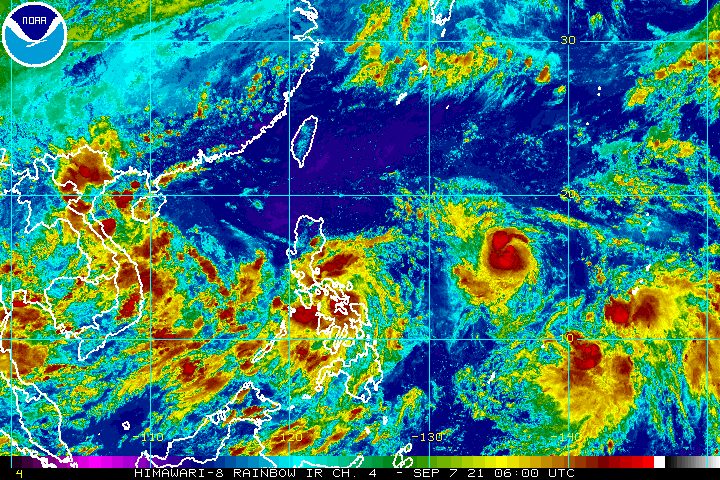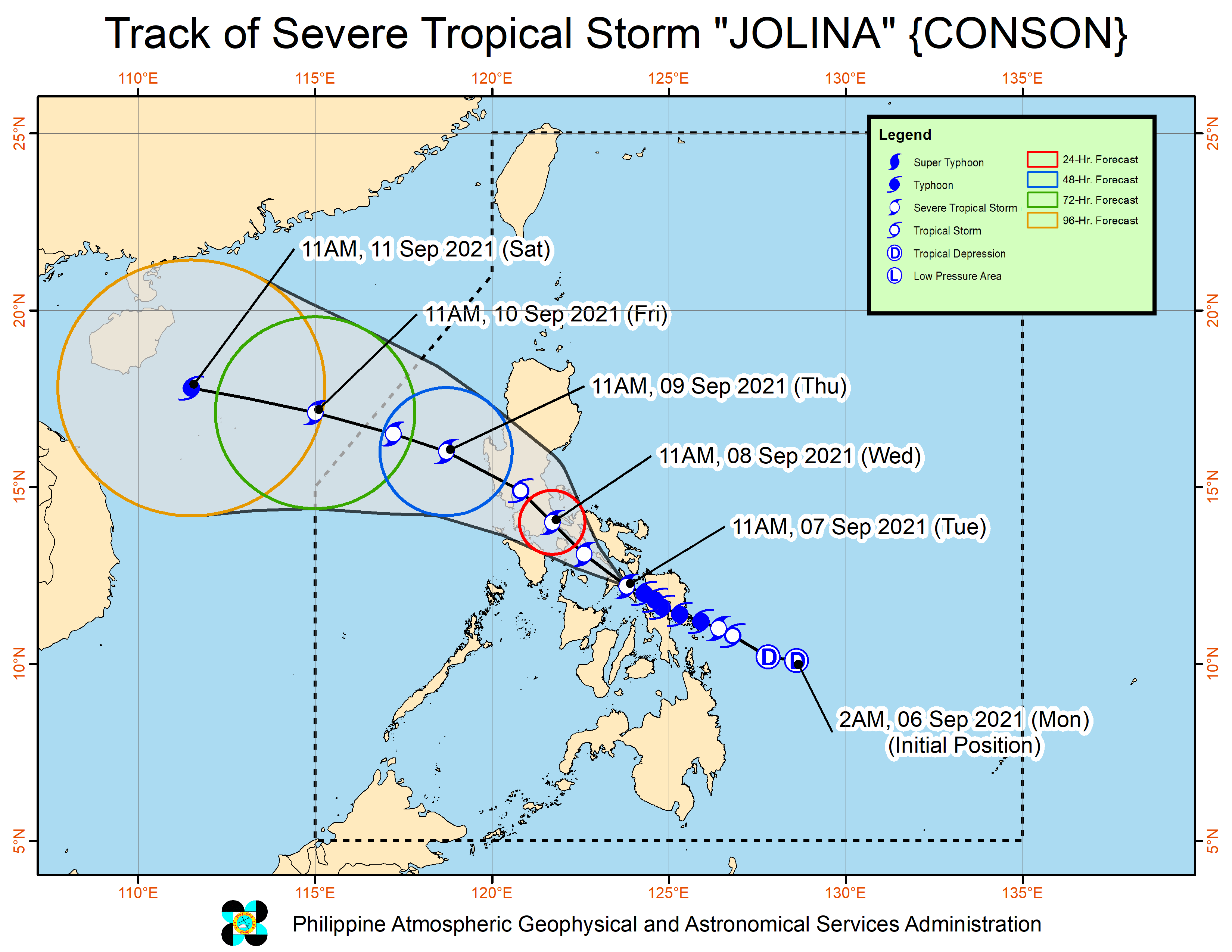SUMMARY
This is AI generated summarization, which may have errors. For context, always refer to the full article.

Jolina (Conson) weakened from a typhoon into a severe tropical storm as it moved over mainland Masbate at 11 am on Tuesday, September 7, the state weather bureau announced mid-afternoon.
Jolina’s maximum sustained winds decreased from 120 kilometers per hour to 110 km/h, prompting the downgrade. Its gustiness is up to 135 km/h.
The severe tropical storm was last spotted in the vicinity of Baleno, Masbate, still moving west northwest at 15 km/h, according to the Philippine Atmospheric, Geophysical, and Astronomical Services Administration (PAGASA).
Though Jolina is no longer a typhoon, it is still bringing torrential rain to parts of Luzon and the Visayas on Tuesday. This means floods and landslides remain possible in areas affected by Jolina.
Heavy to intense rain, with at times torrential rain
- Masbate
- Leyte
- Biliran
- Samar
- Northern Samar
- Sorsogon
- Albay
- Catanduanes
- Camarines Norte
- Camarines Sur
- southern part of Quezon
- Romblon
- Marinduque
Moderate to heavy rain, with at times intense rain
- rest of Visayas
- rest of Calabarzon
- Occidental Mindoro
- Oriental Mindoro
Signal No. 3 has been lifted as of 2 pm on Tuesday, but many areas remain under Signal Nos. 1 and 2. (READ: Why is it now called tropical cyclone ‘wind’ – and not ‘warning’ – signals?)
Signal No. 2 (damaging gale-force to storm-force winds)
- Masbate including Ticao and Burias Islands
- northern part of Romblon (San Fernando, Cajidiocan, Magdiwang, Romblon, Corcuera, Banton, Concepcion, Calatrava, San Agustin, San Andres)
- Sorsogon
- Albay (Polangui, Oas, Ligao City, Guinobatan, Camalig, Daraga, Legazpi City, Manito, Jovellar, Pio Duran, Libon)
- western and southern parts of Camarines Sur (Bato, Nabua, Balatan, Iriga City, Baao, Bula, Ocampo, Pili, Naga City, Canaman, Pamplona, Milaor, Gainza, Camaligan, San Fernando, Minalabac, Pasacao, Libmanan, Magarao, Cabusao, Bombon, Sipocot, Lupi, Ragay, Del Gallego)
- western part of Camarines Norte (Paracale, Jose Panganiban, Capalonga, Santa Elena, Labo, San Vicente, San Lorenzo Ruiz)
- central and southern parts of Quezon (Tagkawayan, Guinayangan, Lopez, Buenavista, San Narciso, San Andres, San Francisco, Mulanay, Catanauan, General Luna, Macalelon, Calauag, Gumaca, Pitogo, Unisan, Atimonan, Plaridel, Agdangan, Padre Burgos, Quezon, Alabat, Perez, Mauban, Tayabas City, Sampaloc, Lucban, Pagbilao, Lucena City, Sariaya, Candelaria, Dolores, Tiaong, San Antonio, Real)
- Laguna
- southeastern part of Batangas (Santo Tomas, Malvar, Balete, Mataasnakahoy, Lipa City, Padre Garcia, Rosario, San Juan, Lobo, Taysan, Ibaan, Batangas City, San Jose, Cuenca)
- Marinduque
- western part of Northern Samar (Lope de Vega, Catarman, Bobon, Victoria, San Jose, Rosario, Lavezares, Biri, Allen, San Isidro, San Antonio, Capul, San Vicente, Mondragon)
- extreme northwestern part of Samar (Calbayog City, Santo Niño, Almagro, Tagapul-an)
- northern part of Biliran (Maripipi, Kawayan, Almeria)
Signal No. 1 (strong winds with occasional gusts)
- rest of Camarines Norte
- rest of Camarines
Sur - rest of Albay
- Catanduanes
- rest of Romblon
- Oriental Mindoro
- Occidental Mindoro
- rest of Quezon
- Rizal
- rest of Batangas
- Cavite
- Metro Manila
- Bulacan
- Bataan
- Nueva Ecija
- Tarlac
- Zambales
- Pampanga
- southern part of Aurora (Dipaculao, Maria Aurora, Baler, San Luis, Dingalan)
- southern part of Quirino (Nagtipunan)
- southeastern part of Nueva Vizcaya (Dupax del Norte, Dupax del Sur, Alfonso Castañeda, Aritao, Santa Fe)
- southern part of Pangasinan (San Nicolas, Natividad, San Quintin, Umingan, Balungao, Santa Maria, Asingan, San Manuel, Tayug, Sison, San Fabian, Pozorrubio, Laoac, Binalonan, Urdaneta City, Rosales, Villasis, Santo Tomas, Alcala, Bautista, Bayambang, Malasiqui, Manaoag, San Jacinto, Mapandan, Santa Barbara, Mangaldan, Dagupan City, Calasiao, San Carlos City, Binmaley, Basista, Urbiztondo, Mangatarem, Aguilar, Lingayen, Bugallon, Infanta, Labrador, Sual, Mabini, Dasol)
- rest of northern Samar
- northern and central parts of Samar (Matuguinao, San Jose de Buan, Gandara, Santa Margarita, Paranas, San Jorge, Tarangnan, Pagsanghan, Motiong, Jiabong, Catbalogan City, Hinabangan, San Sebastian, Calbiga, Pinabacdao, Villareal, Talalora, Santa Rita, Daram, Zumarraga)
- northern part of Eastern Samar (Jipapad, Arteche, Maslog, Dolores, Oras, San Policarpo)
- rest of Biliran
- northern part of Leyte (Calubian, San Isidro, Leyte, Tabango, Villaba, Matag-ob, Kananga, Capoocan, Carigara, Jaro, Alangalang, San Miguel, Babatngon, Tacloban City, Santa Fe, Palompon, Isabel, Merida, Ormoc City, Dagami, Tabontabon, Tanauan, Pastrana, Barugo, Tunga, Palo, Tolosa, Burauen, Albuera)
- northern part of Cebu (Daanbantayan, Medellin, Santa Fe, Bantayan Islands, Bogo City, San Remigio, Tabogon, Borbon, Tabuelan, Sogod, Tuburan, Catmon, Carmen, Danao City, Asturias, Compostela, Camotes Islands, Liloan, Consolacion, Cebu City, Balamban, Mandaue City)
- northern part of Negros Occidental (Cadiz City, Manapla, Enrique B. Magalona, Victorias City, Sagay City, Escalante City, Toboso, Calatrava, Silay City)
- northern part of Iloilo (Carles, Estancia, Balasan, Batad, San Dionisio, Concepcion, Sara, Ajuy, Lemery, San Rafael, Barotac Viejo, Passi City, Bingawan)
- Capiz
- Aklan
Storm surges 0.5 to 1 meter high could hit coastal areas in the following provinces in the next 24 hours, possibly threatening life and property:
- Biliran
- Sorsogon
- Samar
- Masbate
“In addition, coastal areas of localities under [tropical cyclone wind signals]…may experience coastal flooding due to hazardous surf conditions,” PAGASA said.
Sea trips remain suspended due to Jolina as well.
Rough to very rough seas (waves 2.5 to 5 meters high)
Travel risky for all vessels, inexperienced mariners should seek safe harbor
- seaboards of areas under Signal No. 2
Moderate to rough seas (waves 1.2 to 2.8 meters high)
Small vessels must take precautionary measures, inexperienced mariners should avoid navigation
- seaboards of areas under Signal No. 1
- remaining seaboards of Visayas
- northern and eastern seaboards of Mindanao
Jolina is projected to continue moving west northwest for the rest of Tuesday. After crossing Masbate and the Ragay Gulf, it might make another landfall in the southeastern part of Quezon on Tuesday evening or early Wednesday morning, September 8.
Jolina made landfall six times as a typhoon:
Monday, September 6
- Hernani, Eastern Samar – 10 pm
Tuesday, September 7
- Daram, Samar – 2 am
- Santo Niño, Samar – 3:40 am
- Almagro, Samar – 6:30 am
- Tagapul-an, Samar – 7:50 am
- Dimasalang, Masbate – 10 am
For the rest of Wednesday until Thursday morning, September 9, Jolina may cross Central Luzon. It would be around east and north of Metro Manila. At that point, it also may weaken further into a tropical storm.
Finally, Jolina could emerge over the West Philippine Sea before noon on Thursday. It may regain strength beginning Thursday afternoon as it heads for the southern China-northern Vietnam area.
It is likely to leave the Philippine Area of Responsibility (PAR) on Friday morning, September 10.

Meanwhile, the tropical depression outside PAR has since intensified into a tropical storm. It was given the international name Chanthu.
PAGASA said Tropical Storm Chanthu was located 1,225 kilometers east of Central Luzon as of Tuesday morning.
It is moving west northwest over the Philippine Sea at 25 km/h.
If Chanthu maintains its speed and direction, it would enter PAR on Tuesday evening or Wednesday morning. Its local name would be Kiko.
At the moment, Chanthu has maximum sustained winds of 85 km/h and gustiness of up to 105 km/h.
It could strengthen further into a severe tropical storm within 12 to 24 hours, and eventually into a typhoon by Thursday.
Fortunately, Chanthu or the potential Kiko is likely to stay far from Philippine landmass.
PAGASA, however, is not ruling out the possibility of Signal No. 1 being raised in extreme Northern Luzon. (READ: FAST FACTS: Tropical cyclones, rainfall advisories)

Jolina is the Philippines’ 10th tropical cyclone for 2021 and the first for September.
For the next six months, these are PAGASA’s estimates for the number of tropical cyclones inside PAR:
2021
- September – 2 or 3
- October – 2 or 3
- November – 2 or 3
- December – 1 or 2
2022
- January – 0 or 1
- February – 0 or 1
An average of 20 tropical cyclones form within or enter PAR each year. (READ: LIST: PAGASA’s names for tropical cyclones in 2021) – Rappler.com
Add a comment
How does this make you feel?




There are no comments yet. Add your comment to start the conversation.